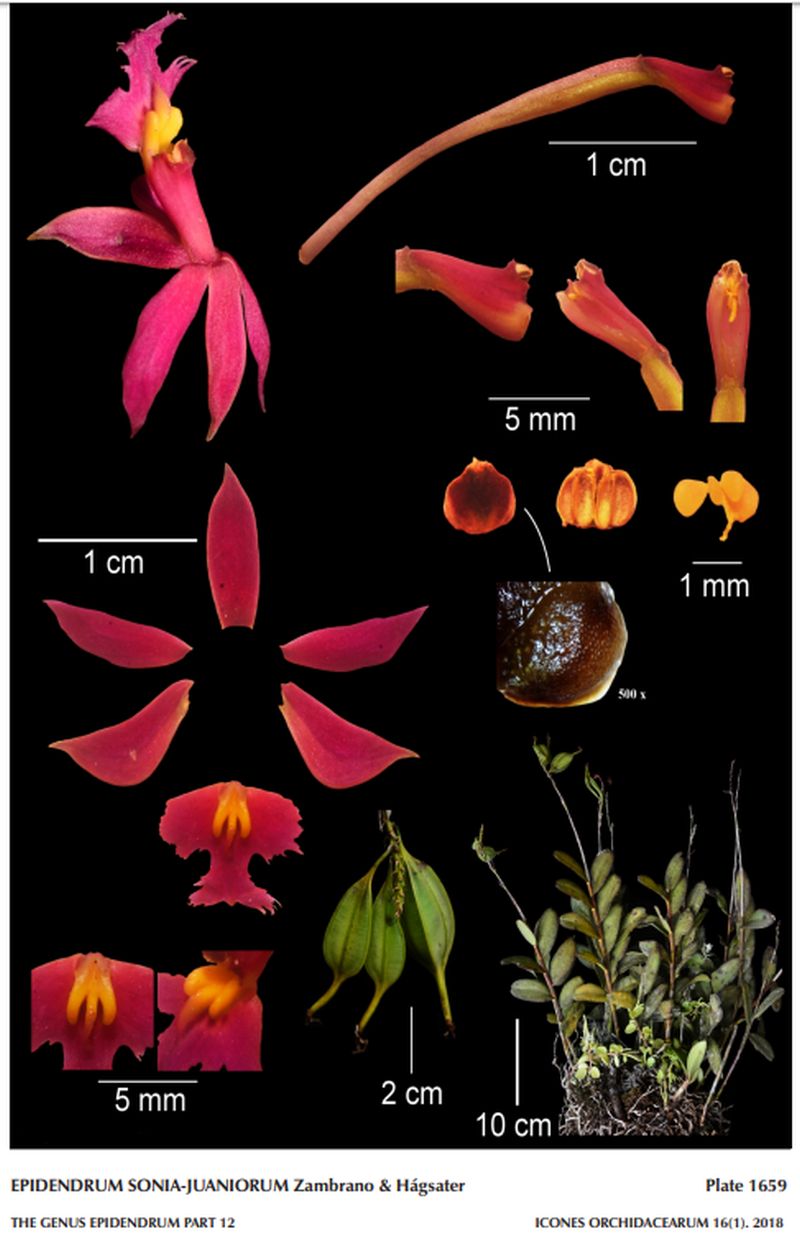

Epidendrum sonia-juaniorum Zambrano & Hágsater 2018 GROUP Secundum SUBGROUP Secundum
TYPE LCDP/TYPE Photo © by B Zambrano and The AMO Herbario Website



Common Name Sonia and the 2 Juan's Epidendrum [Ecuadorians, Sonia, Juan y Juan Moreno parents and brother of the first author, who have contributed substantially in his research of the Orchidaceae family current]
Flower Size .8" [2 cm]
Found in southwestern El Oro province of Ecuador , on the western slopes of the Andes, in scarce moss in semi-deciduous montane forest at elevations of 1300 to 1400 meters as a medium to large sized, cool growing epiphyte with simple, cane-like, terete, straight to slightly curved stems, the basal part covered by several non-foliar, chartaceous, grayish, imbricated, tubular sheaths and carrying numerous, distributed along the apical half of the stem; with basal, tubular, thin, smooth to slightly striated, green, sometimes with purple spots sheaths; blade , oblong-elliptic, apex emarginate, coriaceous, green, margin of the upper side and the lower side sometimes purple leaves that blooms in the winter on a terminal, peduncle 5.2" [13 cm] long, elongate, terete, straight to slightly curved, covered by 5 to 6 chartaceous, grayish, imbricated, acuminate, tubular bracts, 6.8 to 10.8" [17 to 27 cm] long, apical from the mature stem, simple to pluri-racemose, erect, producing 1-2 new racemes from the upper nodes of the peduncle, successively 6 to 8, many flowered inflorescence with much shorter than the ovary, triangular, chartaceous, acuminate floral breacts and carrying floral buds in various stages of development, non-resupinate, fuchsia flowers with the apex of the column and anther darker fuchsia, calli and base of the mid-rib yellow; fragrance none.
"Epidendrum sonia-juaniorum belongs to the GROUP Secundum SUBGROUP Secundum which is characterized by the caespitose habit, simple, terete, stems, numerous, oblong-elliptic, leaves, mostly elongate inflorescence, with a raceme of successive flowers, the lip with two calli and a prominent, flexuous keel. The species is recognized by the fuchsia colored flowers, calli and mid-rib yellow, sepals .44 to .48" [11 to 12 mm] long, column .24 to .28" [6 to 7 mm] long, and the habit which appears to be exclusively epiphytic. It is similar to Epidendrum thermophilum Hágsater and Dodson which also has non-resupinate, flowers but the color reddish-purple, lip obscurely 3-lobed, basal margins straight and somewhat retrorse, lateral lobes obcuneate with the distal margin deeply fimbriate, mid-lobe sub-quadrate, margins deeply fimbriate, and is found terrestrial in northern Ecuador. Epidendrum ibaguense Kunth, which has resupinate flowers about the same size, sepals being .48 to .52" [12 to 13 mm] long, column .32" [8 mm] long, orange-red, the lip orange with some dots on the disc, column orange-red, sometimes orange towards the apex; this species is found exclusively terrestrial in the highlands of northern Colombia on the Cordillera Central and Cordillera Oriental of Colombia. Epidendrum mimopsis Hágsater & Dodson, from Zumba, on the southern tip of Ecuador and on the Amazon side of the Andes, has somewhat similar flowers, but these are purple, with yellow calli and mid-rib, sepals .56 to .6" [14 to 15 mm] long. Epidendrum aromoense Cornejo & Hágsater, has red flowers with a complex yellow callus, and is also found epiphytic in known from the seasonally foggy very dry coastal forests of El Aromo and Montecristi, located ca. 20 km apart from each other in the Province of Manabí in western Ecuador, at ca. 200 m altitude." Hagsater etal 2018
Synonyms
References W3 Tropicos, Kew Monocot list , IPNI ; *Icones Orchidacearum 16[1} Plate 1659 Hagsater & Sanchez 2018 drawing/photo fide;
----------------------------------------------------------------------------------------------------------